The Egg Stabilizer Market is estimated to be valued at USD 1.1 billion in 2025 and is projected to reach USD 1.6 billion by 2035, registering a compound annual growth rate (CAGR) of 3.9% over the forecast period.
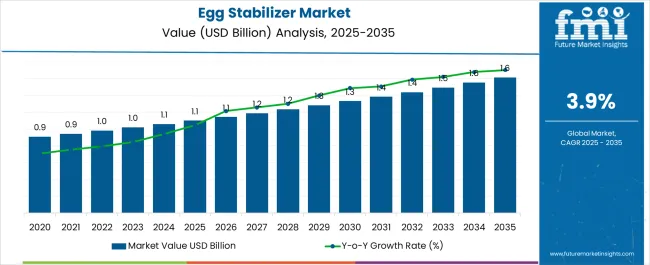
| Metric | Value |
|---|---|
| Egg Stabilizer Market Estimated Value in (2025 E) | USD 1.1 billion |
| Egg Stabilizer Market Forecast Value in (2035 F) | USD 1.6 billion |
| Forecast CAGR (2025 to 2035) | 3.9% |
The Egg Stabilizer market is experiencing consistent growth due to increasing demand for processed and bakery products that require stable egg-based formulations. The market is being influenced by the rising consumption of convenience foods, frozen desserts, and ready-to-eat bakery products, where egg stabilizers play a crucial role in maintaining texture, volume, and shelf life. In addition, the growing awareness of food quality and consistency across both commercial and household applications is supporting adoption.
Manufacturers are increasingly investing in advanced stabilizer formulations that improve whipping properties, emulsification, and heat stability. The expansion of the global bakery and confectionery industry, along with the rapid growth of foodservice and catering sectors, is further boosting demand.
Increasing preference for clean-label and natural ingredients in processed foods is prompting innovation in egg stabilizer formulations As production volumes rise and distribution networks expand, the market is expected to maintain steady growth, driven by a combination of product performance, regulatory compliance, and consumer demand for high-quality, stable food products.
The egg stabilizer market is segmented by type, distribution channel, and geographic regions. By type, egg stabilizer market is divided into Cream Of Tartar, Starch & Derivatives, Sugar, and Gums. In terms of distribution channel, egg stabilizer market is classified into Wholesale, Online Retailer, Supermarket, and Specialty Stores. Regionally, the egg stabilizer industry is classified into North America, Latin America, Western Europe, Eastern Europe, Balkan & Baltic Countries, Russia & Belarus, Central Asia, East Asia, South Asia & Pacific, and the Middle East & Africa.
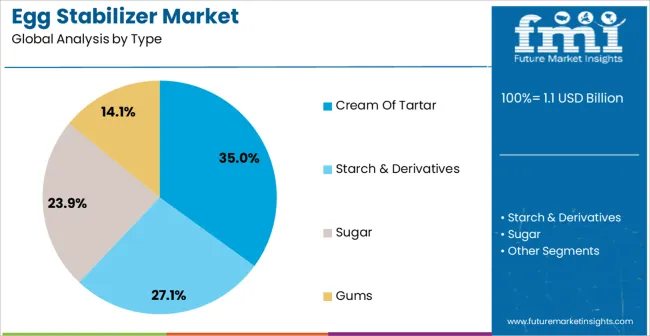
The Cream Of Tartar type is projected to hold 35.00% of the Egg Stabilizer market revenue share in 2025, making it the leading type segment. This dominance is being attributed to its natural origin and effectiveness in providing superior stabilization in meringues, whipped toppings, and bakery applications. Adoption has been facilitated by its ability to maintain foam volume, prevent crystallization, and enhance texture without the need for artificial additives.
The segment’s growth is further supported by the increasing demand for clean-label food products and the preference for natural ingredients in bakery and confectionery industries. Manufacturers are leveraging the functionality of Cream Of Tartar to deliver consistent results across varying processing conditions, which has strengthened its position in the market.
Additionally, its compatibility with multiple egg-based formulations and widespread availability has enabled scalable production for both commercial and retail applications As the global food industry continues to emphasize quality, convenience, and functional performance, the Cream Of Tartar type segment is expected to sustain its market leadership.
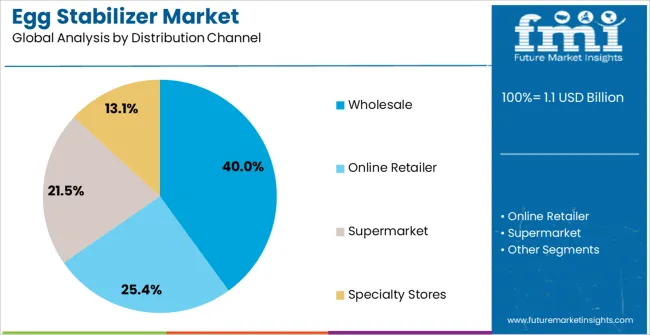
The Wholesale distribution channel is anticipated to account for 40.00% of the Egg Stabilizer market revenue in 2025, making it the largest distribution channel. This leadership is being driven by the efficiency and cost-effectiveness offered through bulk supply to bakery manufacturers, foodservice providers, and industrial users. Wholesale distribution allows for streamlined logistics, reduced per-unit cost, and consistent product availability across regions, which has facilitated adoption at a large scale.
The growth of commercial bakeries, catering services, and institutional food operations has reinforced the reliance on wholesale channels for timely and reliable procurement. Additionally, wholesalers provide flexible packaging and quantity options that meet the requirements of both small and large-scale manufacturers.
The ability to deliver products to multiple end-users efficiently has enhanced the attractiveness of this distribution channel As the egg stabilizer market continues to expand, wholesale channels are expected to remain dominant due to their role in supporting large-scale production, ensuring supply chain stability, and enabling access to diverse customer segments.
A chemical called an egg stabilizer is employed in a variety of food products to stop the separation or degradation of eggs. Cakes, custards, and puddings are just a few examples of meals that frequently include them. The natural thickening and egg stabilizer sodium alginate, which comes from seaweed, is a popular egg stabilizer. To assist maintain a uniform and smooth texture, it is frequently employed in the creation of baked goods, sauces, and dressings.
To stabilize whipped egg whites for recipes like meringue, soufflé, angel food cake, sponge or Chiffon cake, and other bakery and confectionery goods, egg stabilizers are a necessary food additive. Typically, to stabilize the egg white, one would use sugar, vinegar, or fresh lemon juice. 90% of the water in egg whites is in the water. The proteins in the egg whites spread out as they are beaten, trapping air molecules. These tiny air molecules produce air bubbles and give the whipped egg white a fluffy quality. The egg stabilizer keeps the egg whites' frothy and thick texture for a longer period of time by preventing the clustering of their denatured proteins.
In our new study, ESOMAR-certified market research and consulting firm Future Market Insights (FMI) offers insights into key factors driving demand for Egg Stabilizer.
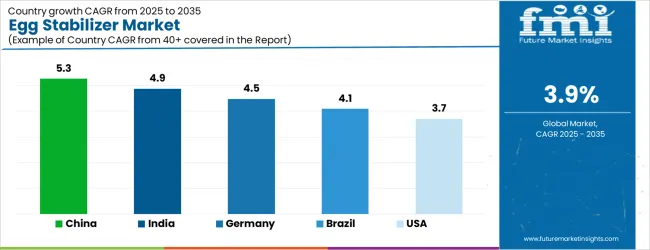
| Country | CAGR |
|---|---|
| China | 5.3% |
| India | 4.9% |
| Germany | 4.5% |
| Brazil | 4.1% |
| USA | 3.7% |
| UK | 3.3% |
| Japan | 2.9% |
The Egg Stabilizer Market is expected to register a CAGR of 3.9% during the forecast period, exhibiting varied country level momentum. China leads with the highest CAGR of 5.3%, followed by India at 4.9%. Developed markets such as Germany, France, and the UK continue to expand steadily, while the USA is likely to grow at consistent rates. Japan posts the lowest CAGR at 2.9%, yet still underscores a broadly positive trajectory for the global Egg Stabilizer Market. In 2024, Germany held a dominant revenue in the Western Europe market and is expected to grow with a CAGR of 4.5%. The USA Egg Stabilizer Market is estimated to be valued at USD 388.7 million in 2025 and is anticipated to reach a valuation of USD 388.7 million by 2035. Sales are projected to rise at a CAGR of 0.0% over the forecast period between 2025 and 2035. While Japan and South Korea markets are estimated to be valued at USD 58.5 million and USD 38.3 million respectively in 2025.
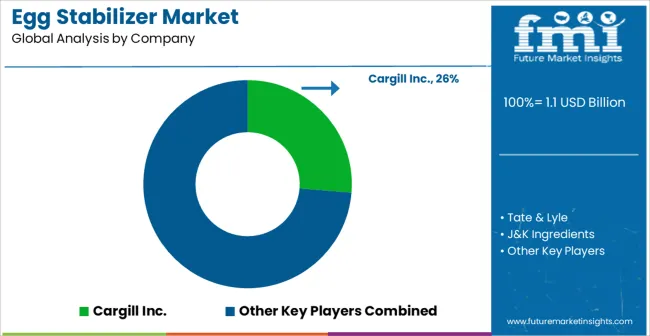
| Item | Value |
|---|---|
| Quantitative Units | USD 1.1 Billion |
| Type | Cream Of Tartar, Starch & Derivatives, Sugar, and Gums |
| Distribution Channel | Wholesale, Online Retailer, Supermarket, and Specialty Stores |
| Regions Covered | North America, Europe, Asia-Pacific, Latin America, Middle East & Africa |
| Country Covered | United States, Canada, Germany, France, United Kingdom, China, Japan, India, Brazil, South Africa |
| Key Companies Profiled | Cargill Inc., Tate & Lyle, J&K Ingredients, Merck KGaA, Ingredion Incorporated, TIC Gums, Holton Food Products, McCormick and Company, and Tártaros Gonzalo Castelló, SL |
The global egg stabilizer market is estimated to be valued at USD 1.1 billion in 2025.
The market size for the egg stabilizer market is projected to reach USD 1.6 billion by 2035.
The egg stabilizer market is expected to grow at a 3.9% CAGR between 2025 and 2035.
The key product types in egg stabilizer market are cream of tartar, starch & derivatives, sugar and gums.
In terms of distribution channel, wholesale segment to command 40.0% share in the egg stabilizer market in 2025.






Our Research Products

The "Full Research Suite" delivers actionable market intel, deep dives on markets or technologies, so clients act faster, cut risk, and unlock growth.

The Leaderboard benchmarks and ranks top vendors, classifying them as Established Leaders, Leading Challengers, or Disruptors & Challengers.

Locates where complements amplify value and substitutes erode it, forecasting net impact by horizon

We deliver granular, decision-grade intel: market sizing, 5-year forecasts, pricing, adoption, usage, revenue, and operational KPIs—plus competitor tracking, regulation, and value chains—across 60 countries broadly.

Spot the shifts before they hit your P&L. We track inflection points, adoption curves, pricing moves, and ecosystem plays to show where demand is heading, why it is changing, and what to do next across high-growth markets and disruptive tech

Real-time reads of user behavior. We track shifting priorities, perceptions of today’s and next-gen services, and provider experience, then pace how fast tech moves from trial to adoption, blending buyer, consumer, and channel inputs with social signals (#WhySwitch, #UX).

Partner with our analyst team to build a custom report designed around your business priorities. From analysing market trends to assessing competitors or crafting bespoke datasets, we tailor insights to your needs.
Supplier Intelligence
Discovery & Profiling
Capacity & Footprint
Performance & Risk
Compliance & Governance
Commercial Readiness
Who Supplies Whom
Scorecards & Shortlists
Playbooks & Docs
Category Intelligence
Definition & Scope
Demand & Use Cases
Cost Drivers
Market Structure
Supply Chain Map
Trade & Policy
Operating Norms
Deliverables
Buyer Intelligence
Account Basics
Spend & Scope
Procurement Model
Vendor Requirements
Terms & Policies
Entry Strategy
Pain Points & Triggers
Outputs
Pricing Analysis
Benchmarks
Trends
Should-Cost
Indexation
Landed Cost
Commercial Terms
Deliverables
Brand Analysis
Positioning & Value Prop
Share & Presence
Customer Evidence
Go-to-Market
Digital & Reputation
Compliance & Trust
KPIs & Gaps
Outputs
Full Research Suite comprises of:
Market outlook & trends analysis
Interviews & case studies
Strategic recommendations
Vendor profiles & capabilities analysis
5-year forecasts
8 regions and 60+ country-level data splits
Market segment data splits
12 months of continuous data updates
DELIVERED AS:
PDF EXCEL ONLINE
Egg Carton Market Size and Share Forecast Outlook 2025 to 2035
Egg Free Premix Market Size and Share Forecast Outlook 2025 to 2035
Egg Protein Market Analysis - Size, Share, and Forecast Outlook 2025 to 2035
Egg Powder Market - Size, Share, and Forecast Outlook 2025 to 2035
Egg White Powder Market Size and Share Forecast Outlook 2025 to 2035
Egg-free Mayonnaise Market Size and Share Forecast Outlook 2025 to 2035
Eggshell Membrane Powder Market Size and Share Forecast Outlook 2025 to 2035
Egg Boiler Market Size and Share Forecast Outlook 2025 to 2035
Egg Processing Machine Market Size and Share Forecast Outlook 2025 to 2035
Egg Grading Machines Market Size and Share Forecast Outlook 2025 to 2035
Egg Breaking Machine Market Size and Share Forecast Outlook 2025 to 2035
Egg Replacement Ingredient Market Analysis - Size, Share & Forecast 2025 to 2035
Egg White Cubes Market Size and Share Forecast Outlook 2025 to 2035
Egg Yolk Oil Market Analysis - Size, Growth and Forecast 2025 to 2035
Egg Emulsifier Market Analysis - Size, Share, & Forecast Outlook 2025 to 2035
Egg and Egg Products Market Analysis - Size, Share, & Forecast Outlook 2025 to 2035
Egg Replacer Market Analysis - Size, Share, and Forecast 2025 to 2035
Egg Albumin Protein Market Analysis - Size, Share, & Forecast Outlook 2025 to 2035
Egg White Substitute Market Analysis – Size, Share, & Forecast Outlook 2025 to 2035
Egg Packaging Market by Packaging Type & Material from 2025 to 2035

Thank you!
You will receive an email from our Business Development Manager. Please be sure to check your SPAM/JUNK folder too.
Chat With
MaRIA